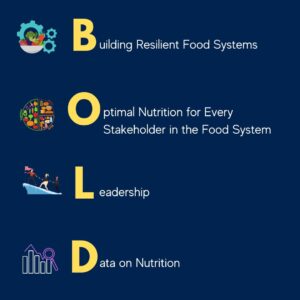COVID-19 has been a watershed moment in terms of the disruptions brought about to public health, nutrition, and the economy. The last 16 months have significantly challenged the developmental gains that world leaders and institutions made over decades towards reducing food insecurity and hunger, two of the most basic and cross-cutting agendas that are critical for attaining all other rights and entitlements. This is especially the case in India.
Sub-optimal Public Health and Nutrition (PHN) has engulfed the subcontinent for a while now. In the first decades of her independence, India was already a backbencher when it came to nutrition indicators and related statistics in the country. Seven decades down the line, and in the wake of State efforts to address this persistent crisis, India still ranks 94th out of 107 countries in the 2020 Global Hunger Index. The subcontinent is home to 189 million undernourished people, the highest for any country in the world. All this is taking place in tandem with increasing numbers of micronutrient deficient and/or obese adults and children.
“The situation [of hunger and malnutrition] was not too good even before March 2020,” says Dipa Sinha, pointing to NFHS-5 data which indicates a stagnation, if not deterioration in most nutrition-status indicators, especially for men and women. COVID-19 has only exacerbated this situation. 
For quite some time now, there have been calls for reform in the way policy decisions on public health and nutrition are made. Investing in solidifying the foundation of India’s future vis-á-vis the good health and nutritional status of its people can be achieved through reimagined and BOLD policy planning.
B for Building Resilient Food Systems
The call of the hour is to build partnerships, collaborations, and networks that help fuel countrywide “nourishment”, and that are insulated to pandemic shocks. It is important to reiterate here that focusing on the availability and distribution of food alone will be insufficient to tackle this.
Cross-sector action is critical to defining India’s next steps: it is important to think of holistic and technically sound solutions that have positive impacts on both food systems and the environment. These need to be operationally feasible at scale—whether in terms of adequate resources or manpower. This reflection is also featured in the Nutrition Coalition of India’s recent Commitment to Action which endorses the joint use of multipronged strategies and multisectoral action for tackling malnutrition. To do this, we first need to understand the intersecting components of India’s food landscape to build and design robust malnutrition policies.
The main bulwark of this sector is the food system. Food systems support the livelihoods of close to one billion people globally. Food insecurity, deterioration in diet quality, micronutrient deficiencies—all of these and more stem from fundamental, complex, and dynamic changes to our food system. Despite the varied impacts that SARS-CoV-2 has had on the world, its aftermath on national, regional, and local food systems have consistently resulted in job losses, income shortfalls, and food shortages. Rises in food waste have also been observed in some low-to-middle-income countries due to lower demand for perishable goods, limited transportation and storage capacities, and retail food price volatility. This has definitive impacts, manifested via worsening malnutrition indicators post-pandemic.
A solution, in this case, could be to build the nutritious quality of the food entering the food system. Shifting from staple crops to other nutritious and climate-resilient alternatives could benefit consumers and the interests of producers of food too—which is the starting point of this diversification of food. For example, Haryana recently announced a financial incentive of ₹7,000 per acre to farmers who are diversifying their crops from water-guzzling paddy to millets, pulses, vegetables, maize, and cotton. Yet, for this method of crop diversification to succeed, healthy and localized diets need to be incorporated into the lifestyles of Indians. There is already an increasing consumer interest (from middle and high-income groups) in ‘nutritious’ foods, which is expected to increase post-COVID. An example is the Realigning Agriculture to Improve Nutrition (RAIN) Project in Zambia which weaves together several components in positively impacting agriculture, skill-building, education and of course nutrition.
Yet, to bring about this change demands the recognition of a critical issue: food systems and agriculture are under immense strain due to climate change. This increases the risks faced by ecologically vulnerable communities or sensitive geographies, worsening the vulnerabilities of food systems and human health. A recent study in The Lancet Planetary Health Journal found that 7,40,000 annual excess deaths in India from 2000 to 2019 could be attributed to abnormally hot and cold temperatures related to climate change. Climate change has also been linked to decreased nutrient levels in commonly eaten crops, as elevated carbon dioxide levels have been shown to lower concentrations of zinc, iron, and protein and raise the starch and sugar content in wheat, rice, and some legumes. A 2016 review summarized the impact of climate change on food security in India: dwindling water availability and the rise in catastrophic climate events in northern India is projected to have far-reaching implications on foodgrain production, livelihoods, and nutrition security among our masses.
Clearly, urgent decisive action at the intersection of agriculture and climate change is warranted to ensure food security and adequate nutrition for all Indians. Yet, to ensure this smooth cross-sectoral collaboration, adequate and uninterrupted funding earmarked for Public Health Nutrition is non-negotiable. While some relief packages by the government do exist alongside sporadic philanthropic initiatives, it is critical to systematise the perennial channelling of resources to deliver health and nutrition to the last mile. While using CSR funds is one method, developing innovative, localised financing models that cater to contextual needs should be encouraged, as seen in Uttar Pradesh’s SAMBHAV program.
Ultimately, nothing is possible without sufficiently trained and skilled human resources implementing nutrition policies on the ground. Yet, reports point out a severe shortage of trained staff in the field. Those who do perform this work have noted that competing priorities, no salary disbursement, and low motivation further affect their performance. This situation has been made worse by the pandemic: reports of overworked frontline workers being asked to carry out additional or emergency duties without incentives and proper training abound. So, it is important to invest in people’s capacity building, such that their deployments yield favourable nutrition outcomes in the long run.
O for Optimal Nutrition for Every Stakeholder in the Food System
We cannot stay healthy and nourished at the cost of our environment or biodiversity, which is why enabling optimal, sustainable, and localised nutrition in the long term is crucial. This will help achieve One Health, or “optimal health outcomes recognizing the interconnection between people, animals, plants, and their shared environment.”
Given that malnutrition manifests in several, often under-recognised forms, we must prioritize plugging knowledge gaps through a combination of research and advocacy. For example, India’s state-led behavioural change efforts when it comes to nutrition are delivered by frontline workers and include advocacy campaigns such as POSHAN Pakhwada or POSHAN Maah. In addition to creating a buzz amongst potential beneficiaries, program leaders should also try to leverage their networks to connect the dots between several other nutrition programs like the ICDS and Mid-day Meal Scheme to understand the minutiae of India’s malnutrition problem.
Poshan (nutrition) month: the importance of anganwadi kitchen gardens. pic.twitter.com/1L6fAnc5DW
— Uma Mahadevan (@readingkafka) August 31, 2021
To prevent food wastage, and thus protect the interests of the environment, promoting local and diverse diets is key. Yet, in a country facing an economic slowdown and rising poverty rates as a result of the pandemic, ensuring access to such food is also key. To that end, healthy diets should be made affordable to the masses through policy instruments like subsidies and tax reforms. Ultra-processed foods high in bad fats, sugars, and salt should be curtailed as much as possible to rein in the country’s struggles with obesity and Non-Communicable Diseases. As always, convergence between sectors is required to achieve this such as nutrition-sensitive agricultural interventions with participatory videos and women’s group meetings, as was done in rural Odisha.
L for Leadership
Leadership is vital in driving aspirations to their goals. Role models, especially at the ground level, inspire and influence behavioural changes when it comes to health. They instil people with the confidence that they too can opt for better health using available resources and government aid. Developing dynamic, innovative, and transformative leaders to take charge of implementing and spreading awareness on nutrition policies is necessary, alongside defining clear mandates, action points, strategies and processes.
That being said, leaders require strong strategic thinking abilities, interpersonal communication skills, and emotional intelligence too, skills that young leaders and youth ambassadors should be nurtured and trained in. Sprinkling this work with periodic ground visits, surprise visits, team-building exercises, mentorship, and transparent engagement with public sentiment will help bolster the performance of frontline workers on the ground.
D for Data on Nutrition
Robust disaggregated nutritional data should inform decision-making on malnutrition in India, as it is critical in determining the nutritional status of populations. In the context of COVID-19, it is imperative that we continue the sustained collection, interpretation, analysis, and management of nutrition-related data to monitor India’s public health.
A recent study demonstrated the importance of precision mapping (collecting data from a smaller geographical unit) and collecting fine-grained data in nutrition indicators rather than using only national-level averages. For stunting, 68.9% of the total variation was attributed to villages, followed by 24.0% to states and around 7% at districts. More than half (54.2%) of the variation in underweight was attributed to villages and the remaining variation was attributed to states (39.5%) and districts (6.2%). Similarly, villages accounted for 72.3% of the variation in wasting. This highlights the importance of granular data in identifying target areas that need priority and for assessing the successes and failures of programmes and policies at local levels. These would help make village health sanitation and nutrition committees and gram panchayats accountable for children’s growth and health.
Exploring innovative approaches to collect vital information without causing any unintended harm and providing adequate and timely information for response planning should be prioritized. One example is the data curated by the World Bank from phone surveys in 48 countries. It indicates that a significant number of people are running out of food or reducing their consumption. This compromised public health and nutrition threaten gains made in poverty reduction and health and could have lasting impacts on the cognitive development of young children.
A B.O.L.D. Vision for a Hunger-free India
Research from the Standing Together for Nutrition (STfN) consortium projects that globally, an additional 141 million people cannot afford a healthy diet due to the impacts of COVID-19–this is on top of the estimated 3 billion already suffering multiple forms of malnutrition globally. “Without swift and strategic responses, the pandemic will not only reverse years of progress and exacerbate disparities, but will jeopardize human capital and economic growth for the next generation. This will have an everlasting impact on their lives, their families, and their countries,” says Saskia Osendarp, the Executive Director Micronutrient Forum and Co-Convener at STfN. “The futures of an entire generation are in jeopardy, and, unfortunately, like in any crisis, women and children are disproportionately affected. COVID-19 response must prioritize nutrition for recovery and to build resilience. There are solutions to correct the course – let’s stand together for nutrition.”
COVID-19 has been a dampener for the public health and nutrition of Indians, but it is time to build back better with science, solidarity, and solutions. As the National Nutrition Month—or Rashtriya Poshan Maah— begins this September, renewed commitment, relentless advocacy, robust policy, and reassuring action on the ground is expected from the government at every level. It is now the collective responsibility of all stakeholders to facilitate the path of good health for all citizens, irrespective of their socio-economic barriers. We must be ready to take BOLD actions to see improvements in PHN.







Very well articulated. I think government should take action on every level.